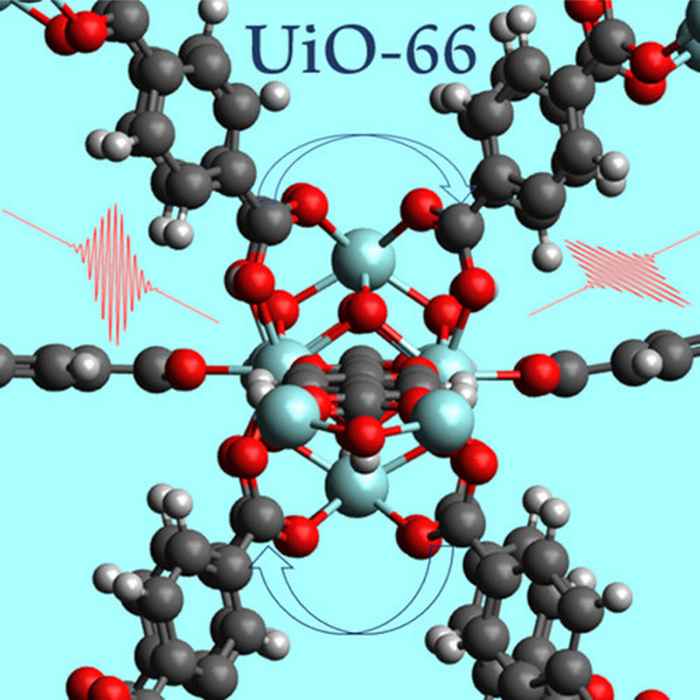Direct probing of vibrational dynamics in a metal-organic framework using femtosecond two-dimensional infrared spectroscopy
10 November 2022

Metal-organic frameworks (MOFs) are materials with highly ordered three-dimensional nanoscopic structures, displaying well-defined pores and channels. In recent years there has been a lot of interest in their use as functional materials for efficient energy conversion and storage. As an example, MOF-based membranes are being developed for applications in the field of fuel extraction and production.
To be able to rationally design such materials, it is crucial to obtain insight on the dynamical processes inside the nanoscopic framework, which consists of metal-oxo clusters connected by organic linkers. One of the promising techniques for such studies is femtosecond two-dimensional infrared spectroscopy (2D-IR). This method excites vibrational transitions in the material and subsequently tracks the dynamics of their relaxation on the femtosecond timescale. These dynamics reflect the structural properties of the material.
First 2D-IR study on UiO-66 membranes
The paper in the Journal of Physical Chemistry Letters reports on the first 2D-IR measurements of polycrystalline membranes of the benchmark MOF UiO-66, which is exceptionally stable and has demonstrated promising performance in many applications. Femtosecond 2D-IR spectroscopy was performed by the Ultrafast Spectroscopy research group led by Prof. Huib Bakker at AMOLF. Researchers at the Functional Materials research group led by Dr Stefania Grecea at the University of Amsterdam’s Van ‘t Hoff Institute for Molecular Sciences assisted in sample preparation of polycrystalline UiO-66 membrane layers that are of adequate thickness and smoothness.
The UiO-66 MOF consists of Zr6O4(OH)4 clusters connected by terephthalate linkers. The 2D-IR study focused on the vibrations of these terephthalate linkers. It is the first work in which vibrational dynamics of the linkers were probed directly without using vibrational probes or guest molecules. The study revealed that vibrations located on different linkers rapidly exchange energy, meaning that energy put in these vibrations quickly delocalizes over the MOF structure. Furthermore, it was found that excited linker vibrations relax with a time constant of 1.3 ps, leading to significant heat accumulation in the material, which effectively increases the local temperature by 10-20°C. Such temperature increase leads to a loosening of the metal-linker interactions on the picosecond timescale. This result is important for further studies of materials with (photo)catalytic and ion-conductive properties. For this, the paper provides a methodological framework. An example is the study of proton conduction at the molecular level, which is a crucial process in developing new efficient fuel cells.
Abstract of the paper
UiO-66 is a benchmark metal–organic framework that holds great promise for the design of new functional materials. In this work, we perform two-dimensional infrared measurements on polycrystalline membranes of UiO-66 grown on c-sapphire substrates. We study the symmetric and antisymmetric stretch vibrations of the carboxylate groups of the terephthalate linker ions and find that these vibrations show a rapid energy exchange and a collective vibrational relaxation with a time constant of 1.3 ps. We also find that the symmetric vibration of the carboxylate group is strongly coupled to a vibration of the aromatic ring of the terephthalate ion. We observe that the antisymmetric carboxylate vibrations of different terephthalate linkers show rapid resonant (Förster) energy transfer with a time constant of ∼1 ps.
Paper details
Korotkevich AA, Sofronov OO, Lugier O, Sengupta S, Tanase S, Bakker HJ: Direct Probing of Vibrational Interactions in UiO-66 Polycrystalline Membranes with Femtosecond Two-Dimensional Infrared Spectroscopy. J Phys Chem Lett. 2022 Oct 27;13(42):9793-9800. DOI: 10.1021/acs.jpclett.2c02509.
See also
- UvA research group Functional Materials
- AMOLF research group Ultrafast Spectroscopy